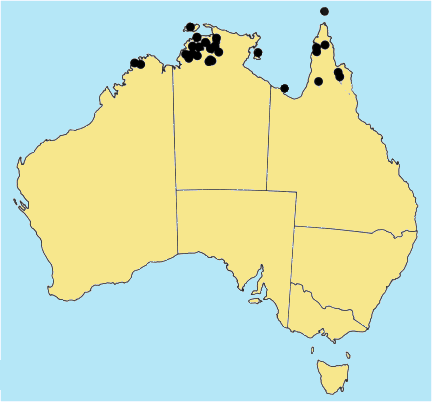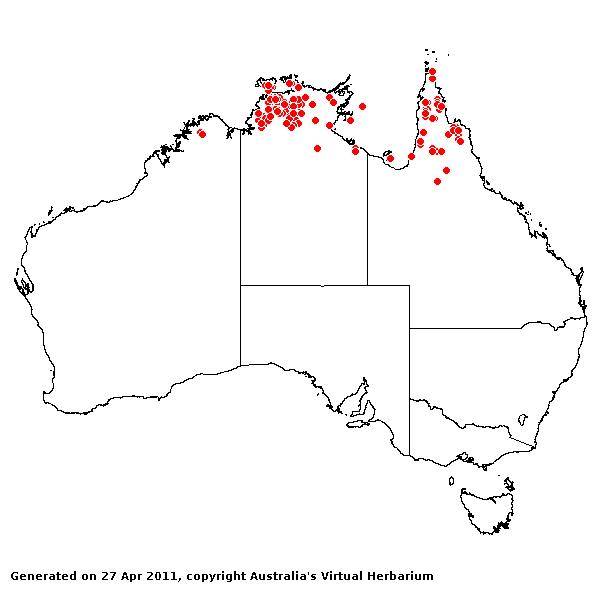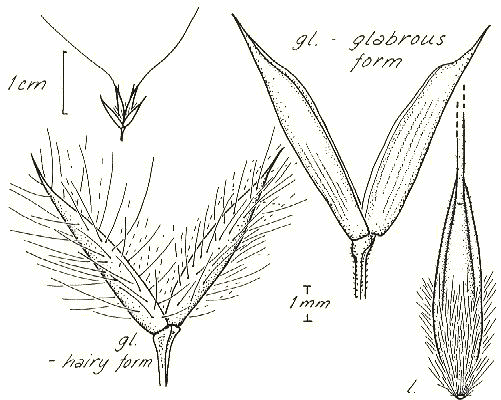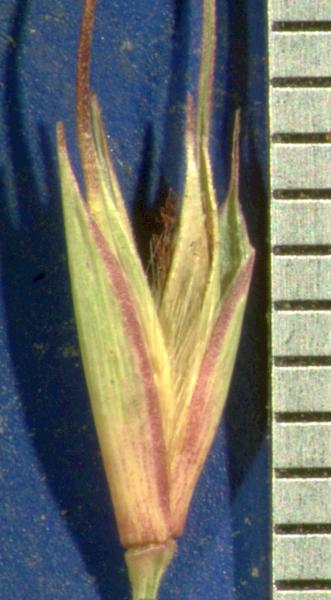Eriachne burkittii Jansen. Meded.Rijks.Herb. Leiden59:1(1930).
Classification. (GPWG 2001) : Subfamily Micrairoideae. Eriachneae.
Type of Basionym or
Protologue Information: LT: Burkitt 12, 1881, Australia: Northern
Territory: Darwin and Gulf District: near Port Darwin, bridge Creek (L [77012];
ILT: BRI, MEL, US-1024920). LT designated by Eck-Borsboom, Blumea 26:
131 (1980).
Recent synonyms:
E. burkittii var. hirsutissima, E. laidlawii.
Key references
(books and floras): [2002] D.Sharp & B.K.Simon, AusGrass, Grasses of
Australia.
Illustrations:
[2005] K.Mallet (ed.), Flora of Australia 44B: Poaceae 3 (Fig.
G-H).
Habit. Annual
or perennial. Culms erect, 40–125 cm tall. Mid-culm nodes glabrous or pubescent
or bearded. Lateral branches simple or branched. Ligule a fringe of hairs.
Leaf-blades 10–35 cm long, 3–5 mm wide. Leaf-blade surface smooth or
scaberulous, glabrous or indumented.
Inflorescence.
Inflorescence compound, a panicle. Panicle elliptic, 10.5–19 cm long, 1–6 cm
wide.
Spikelets.
Spikelets pedicelled. Fertile spikelets 2-flowered, both fertile, comprising 2
fertile floret(s), without rachilla extension, ovate, laterally compressed,
5.5–6 mm long.
Glumes.
Glumes similar, thinner than fertile lemma. Lower glume lanceolate, membranous,
without keels, 9–13 -nerved. Lower glume surface glabrous or indumented. Lower
glume apex mucronate or awned. Upper glume lanceolate, 4.3–10 mm long,
membranous, without keels, 9–13 -nerved. Upper glume surface smooth or
scabrous, glabrous or indumented. Upper glume apex mucronate or awned.
Florets.
Fertile lemma 5–7 mm long, without keel, 5–7 -nerved. Lemma surface indumented.
Lemma apex awned, 1 -awned. Median (principal) awn 10–30 mm long overall. Palea
apex entire or dentate, muticous. Grain 2–2.8 mm long.
Continental
Distribution: Australasia.
Australian
Distribution: Western Australia, Northern Territory, Queensland.
Western Australia:
Gardner. Northern Territory: Darwin & Gulf. Queensland: Cook,
Burke.
Notes.
Characterised by its leafy perennial habit, purple colouring, large open
drooping panicle, firm glumes, florets usually longer than glumes with
appressed lemma and palea, and bisulcate scabrous lemmas with recurved
semi-articulated awn. Also, the palea is beaked, hairy near the keels, and its
keels are glabrous and rounded in the lower part, and scabrous and acute above.
On the flaps, there are broad hyaline wings. It appears that plants with
glabrous glumes and entirely or partly glabrous leaves are predominant.
However, hairy individuals occur periodically in the same population and both
conditions on the same plant. Particularly in the panicle, E. burkittii
resembles E. stipacea, but the latter species has longer glumes and
lemma awns, an entirely hirsute (not partly glabrous) lemma with two grooves,
and two-awned paleas.
Native.
N of 16ºS in Qld, N.T. and W.A.; also in Papua New Guinea. A characteristic
species of the seasonally inundated, heavy clay floodplains, which occur
extensively in N.T. N of 14ºS. Other recorded habitats include the margins of
swamps and lagoons, alluvial floodouts, seepage areas and drainage depressions.
Flowers and fruits Mar.-July (autumn to mid-winter); also Jan. (summer) and
Oct. (spring).





